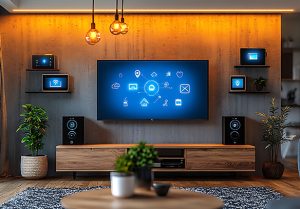Have you ever wished your house could help you cut costs and save energy without additional work? Smart house automation enables this. Using technology to control heating, cooling, appliances, and lights will help to save energy waste and expenses. There are several ways to make your house more efficient, regardless of your present setup or level of automation desire. Little adjustments like adopting smart thermostats and energy-monitoring plugs can result in clear savings. This blog will walk you through doable actions to make your house more affordable and smart. These suggestions not only cut your monthly costs but also help you use less energy generally. Let’s look at how little changes could greatly improve your house and finances.
Install a Smart Thermostat for Better Temperature Control
Your energy bill spends a lot of money on heating and cooling. Learning your behaviors and automatically changing a smart thermostat lets you more effectively control indoor temperature. Unlike conventional thermostats, which call for manual adjustments, smart ones link to Wi-Fi and permit remote control via a smartphone app.
Features like scheduling, geofencing, and weather-based changes abound on many smart thermostats. Scheduling allows you to establish various tempers at various daily hours. Geofencing changes the temperature based on your leaving or returning home. Some devices even track outside temperature to maximize inside settings.
You might save up to 10% yearly on heating and cooling expenses by adjusting your thermostat a few degrees higher in summer and lower during winter when you’re not home. Selecting a model fit for your HVAC system guarantees maximum return on your purchase.
Use Smart Lighting to Reduce Electricity Waste
One regular waste of energy is leaving lights on in vacant rooms. Smart lighting solutions aid you in gaining more control over how and when lights are used. Motion sensors, voice commands, and smartphone apps let you readily turn lights on and off without touching a switch.
LED technology drives smart lamps, which use less power than conventional incandescent lighting. Many versions additionally enable dimming, therefore cutting the energy use even more. You can create plans whereby lights switch off automatically when not needed or change brightness depending on the time of day.
Motion-activated smart lights for outdoor illumination stop needless use and enhance security. Certain systems even coordinate with sunrise and sunset periods to guarantee that lights only turn on as needed. These little changes will help you to have a pleasant and well-lit house while lowering electricity expenses.
Smart Plugs Help Manage Energy Consumption
Many domestic appliances run on electricity even when they are turned off. Over time, these “phantom loads” mount up and raise energy costs. Smart plugs cut power to gadgets while they’re not in use.
Connecting smart plugs to your Wi-Fi network lets you operate them from a distance. With a phone app, you can create plans, turn off appliances, or use voice commands via Alexa or Google Assistant. Certain models even track energy use, displaying the power each gadget uses.
Smart plug use on appliances, including gaming consoles, TVs, and coffee machines, helps to prevent wasted electricity. Setting timers guarantees that appliances turn off automatically, therefore cutting monthly costs and wasteful power use.
Automate Blinds and Curtains for Temperature Control
Heating and cooling your house depends much on windows. Summertime sunshine coming in via windows can raise indoor temperatures, which increases air conditioning demand. Poorly insulated windows in winter allow heat to escape, therefore raising heating expenses. Automatically changing depending on sunlight and temperature, smart blinds and curtains assist.
Certain smart blinds change based on outside temperature and link to weather applications. Others have light sensors that open or close them based on sun level. By relieving stress on your HVAC system, this automation helps to save energy.
Motorized retrofit kits can convert current blinds into smart ones if changing all of your window coverings isn’t possible. Programming schedules to open and close at designated periods will help to maximize insulation and comfort while using less energy.
Optimize Appliance Use with Smart Scheduling
Many home equipment run unnecessarily, consuming a lot of power. By letting you control when these appliances run, smart scheduling guarantees effective use of energy.
High energy needs abound in washing machines, dishwashers, and dryers. Running them during off-peak times when electricity prices are lower will help you save money. Through an app, some smart home systems let you set appliances to run at designated times.
Though always functioning, refrigerators can still be optimized. Maintaining cooling efficiency depends on keeping them well-stocked; appropriate temperature setting helps to avoid misuse. By sending alarms when the door is left open or when temperatures fluctuate, smart refrigerators help to prevent energy waste.
Smart scheduling guarantees that appliances run as needed, therefore lowering energy costs and maintaining a flawless functioning state of your house.
Home Energy Monitoring for Smarter Decision-Making
Reducing waste requires first knowing where your energy is going. Real-time tracking of electricity use by smart energy meters indicates which appliances run most often. These realizations enable you to make wise selections regarding the reduction of pointless energy consumption.
Certain energy monitors link straight to your electricity panel to fully break out household consumption. Others deal with specific appliances, so you may identify energy-hungry equipment. Many devices deliver waste-reducing advice along with reports straight to your smartphone.
Examining these figures will help you spot trends and modify your use. If a certain gadget consumes more than predicted, it can need replacement or maintenance. Real-time data lets you respond right now to cut energy expenditures.
Smart Water Heaters Improve Energy Efficiency
A good fraction of residential energy consumption is related to heating water. By varying heating schedules depending on usage patterns, a smart water heater helps to lower waste.
Conventional water heaters keep water hot at all times, which results in needless energy consumption, even in empty homes. Smart models guarantee that heating runs just when necessary by allowing scheduling. Some even pick up your routine and modify it appropriately.
Installing a smart controller might have similar advantages for households with current water heaters. These controllers let you change temperatures far away and link to Wi-Fi. Lowering temperatures during non-use will help cut standby energy loss and save money.
Conclusion
Smart home automation presents a sensible approach to keeping comfort while cutting energy use. Little adjustments in everything from smart thermostats and lighting to energy monitoring and controlled appliances can add significant savings. These technologies simplify daily living and help you reduce energy use. Adopting some clever ideas will help you design a house that runs effectively without additional work. Start with little changes and then increase as you find advantages. Using the correct strategy can let you keep your energy expenditures under control and enjoy a smarter house.


